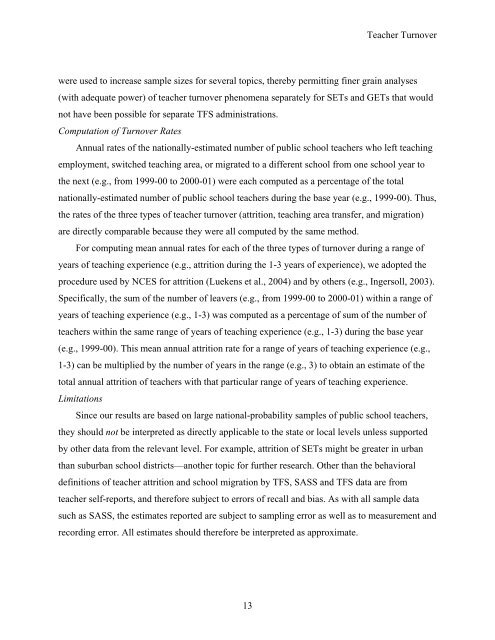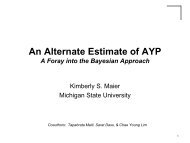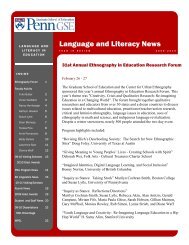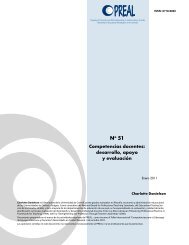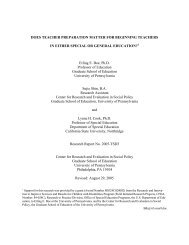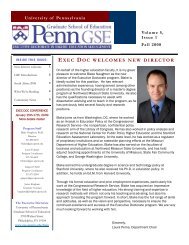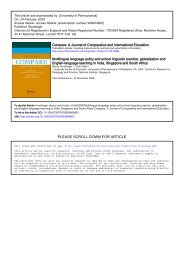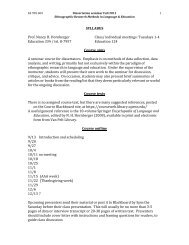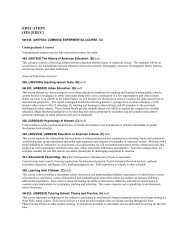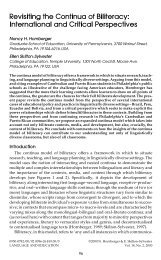Teacher turnover in special and general education: attrition
Teacher turnover in special and general education: attrition
Teacher turnover in special and general education: attrition
You also want an ePaper? Increase the reach of your titles
YUMPU automatically turns print PDFs into web optimized ePapers that Google loves.
<strong>Teacher</strong> Turnover<br />
were used to <strong>in</strong>crease sample sizes for several topics, thereby permitt<strong>in</strong>g f<strong>in</strong>er gra<strong>in</strong> analyses<br />
(with adequate power) of teacher <strong>turnover</strong> phenomena separately for SETs <strong>and</strong> GETs that would<br />
not have been possible for separate TFS adm<strong>in</strong>istrations.<br />
Computation of Turnover Rates<br />
Annual rates of the nationally-estimated number of public school teachers who left teach<strong>in</strong>g<br />
employment, switched teach<strong>in</strong>g area, or migrated to a different school from one school year to<br />
the next (e.g., from 1999-00 to 2000-01) were each computed as a percentage of the total<br />
nationally-estimated number of public school teachers dur<strong>in</strong>g the base year (e.g., 1999-00). Thus,<br />
the rates of the three types of teacher <strong>turnover</strong> (<strong>attrition</strong>, teach<strong>in</strong>g area transfer, <strong>and</strong> migration)<br />
are directly comparable because they were all computed by the same method.<br />
For comput<strong>in</strong>g mean annual rates for each of the three types of <strong>turnover</strong> dur<strong>in</strong>g a range of<br />
years of teach<strong>in</strong>g experience (e.g., <strong>attrition</strong> dur<strong>in</strong>g the 1-3 years of experience), we adopted the<br />
procedure used by NCES for <strong>attrition</strong> (Luekens et al., 2004) <strong>and</strong> by others (e.g., Ingersoll, 2003).<br />
Specifically, the sum of the number of leavers (e.g., from 1999-00 to 2000-01) with<strong>in</strong> a range of<br />
years of teach<strong>in</strong>g experience (e.g., 1-3) was computed as a percentage of sum of the number of<br />
teachers with<strong>in</strong> the same range of years of teach<strong>in</strong>g experience (e.g., 1-3) dur<strong>in</strong>g the base year<br />
(e.g., 1999-00). This mean annual <strong>attrition</strong> rate for a range of years of teach<strong>in</strong>g experience (e.g.,<br />
1-3) can be multiplied by the number of years <strong>in</strong> the range (e.g., 3) to obta<strong>in</strong> an estimate of the<br />
total annual <strong>attrition</strong> of teachers with that particular range of years of teach<strong>in</strong>g experience.<br />
Limitations<br />
S<strong>in</strong>ce our results are based on large national-probability samples of public school teachers,<br />
they should not be <strong>in</strong>terpreted as directly applicable to the state or local levels unless supported<br />
by other data from the relevant level. For example, <strong>attrition</strong> of SETs might be greater <strong>in</strong> urban<br />
than suburban school districts—another topic for further research. Other than the behavioral<br />
def<strong>in</strong>itions of teacher <strong>attrition</strong> <strong>and</strong> school migration by TFS, SASS <strong>and</strong> TFS data are from<br />
teacher self-reports, <strong>and</strong> therefore subject to errors of recall <strong>and</strong> bias. As with all sample data<br />
such as SASS, the estimates reported are subject to sampl<strong>in</strong>g error as well as to measurement <strong>and</strong><br />
record<strong>in</strong>g error. All estimates should therefore be <strong>in</strong>terpreted as approximate.<br />
13


